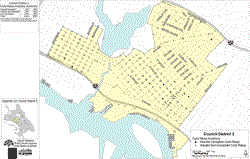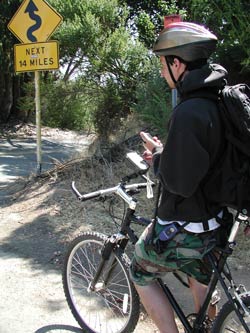Innovative Methods Speed Curb Ramp Survey
By Andy Yan, City of Oakland, California
Although an accessible city has been the goal of many public works officials, city engineers, and urban planners who design cities, federal legislation now mandates that cities ensure that infrastructure, such as sidewalks, may be used by everyone. Traditional desktop GIS and the emerging field of mobile GIS are proving invaluable tools in meeting the requirements of the Americans with Disabilities Act (ADA). GIS is helping officials understand ADA compliance and identify improvements needed to achieve it.
 |
| Field-workers conducting the survey were deployed on bicycles equipped with iPAQs. After identifying and confirming each curb ramp location, the worker entered its location and added required information to the ArcPad form. |
Locating Curb Ramps
In a proactive move by the city of Oakland, California, the Public Works Agency (PWA) ordered a comprehensive inventory of the city's curb ramps. ADA legislation gives specific guidelines regarding the design of curb ramps so they are accessible by persons with mobility or visual impairments. Although the city had a robust database of city streets and parcels, no data existed on curb ramps. Because curb ramps are frequently located underneath trees, this information could not be extracted from existing data layers or interpreted from the city's air photo database. PWA needed a complete intersection survey of the entire city.
Pen and Paper Inventorying
Previously, this type of infrastructure inventory would be done with pen and paper. Workers, sent into the field with clipboards, maps, and survey forms, would log each curb. After the initial survey, the collected data would be entered—record by record—into a GIS program. Only then could maps be generated and spatial analyses performed. This process is not only time consuming and expensive but also subject to error when paper notes are converted to digital data. For Oakland, which encompasses 53.8 square miles and includes 835 miles of streets, the traditional paper-pen method would have meant months of data gathering and weeks of data entry. This would have made the project too expensive to be feasible.
Developing a Solution
3D Visions was selected as the technical consultant for the project. The company was tasked with choosing a digital survey instrument for the project. 3D Visions specializes in the development and deployment of mobile GIS solutions and has created many blight survey tools for clients in the Bay area of northern California. Previous projects focused on supplying attribute data to preexisting polygon layers, typically parcel files. The Oakland project required the creation of a new point layer showing curb ramp locations.
 |
| The comprehensive inventory of Oakland's curb ramps produced a final data layer of approximately 20,000 points that showed the locations of ADA- and non-ADA-compliant curb ramps. |
ArcPad has proven to be an important tool for creating user-friendly data capture forms for mobile GIS applications. With the recent release of ArcPad 6 and ArcPad Application Builder, forms can be quickly built and deployed. The ability to utilize Visual Basic Scripting (VBScript), new with ArcPad 6, allows for an extra level of data validation and data quality assurance. ArcPad in the Hewlett–Packard iPAQ handheld computer has proven to be a cost-effective platform for mobile GIS.
Working with the city of Oakland and Geotopo, a mapping and surveying consulting company, 3D Visions helped determine the inventory needs and parameters for the project. This required defining what constituted a curb ramp and an obstruction to a ramp and what was necessary for a ramp to be ADA compliant. Training material was needed to ensure that the field surveyors understood the rating criteria. Also, a survey of this scope provided a unique opportunity for additional data to be gathered.
Conducting the Survey
The final surveying tool was built using the city's street centerline layer. However, to accommodate the limitations of the memory and processing speed of the iPAQs, the street layer was clipped to the city's planning areas. These clipped sections were distributed to field surveyors each day. This street layer was essentially a rubber sheet, which provided a reference layer that field-workers could use to place curb ramp points.
Field surveys are typically conducted from a vehicle or on foot. For efficiency, the field-workers were deployed on bicycles in teams of two and assigned to specific inventory areas each day. The iPAQs were mounted on each bicycle's handlebars. After identifying and confirming a location, a surveyor would enter its location as a point. A form containing the city's parameters for curb inventorying would then appear on the iPAQ, and the worker would fill in the required information. Each afternoon, data from the iPAQs was downloaded and integrated into a central database.
The final data layer of approximately 20,000 points fulfilled two purposes. Maps of the results were prepared in ArcView. The curb ramp data identified the location of ADA- and non-ADA-compliant curb ramps so the city knew how much work was needed for compliance. In addition, this data also provides the basis for a capital improvement plan estimate that can be developed to fund future projects for ADA compliance for the city of Oakland.
|